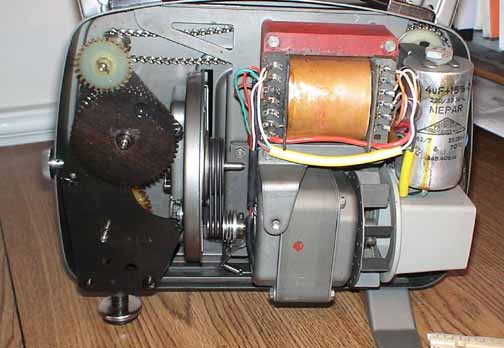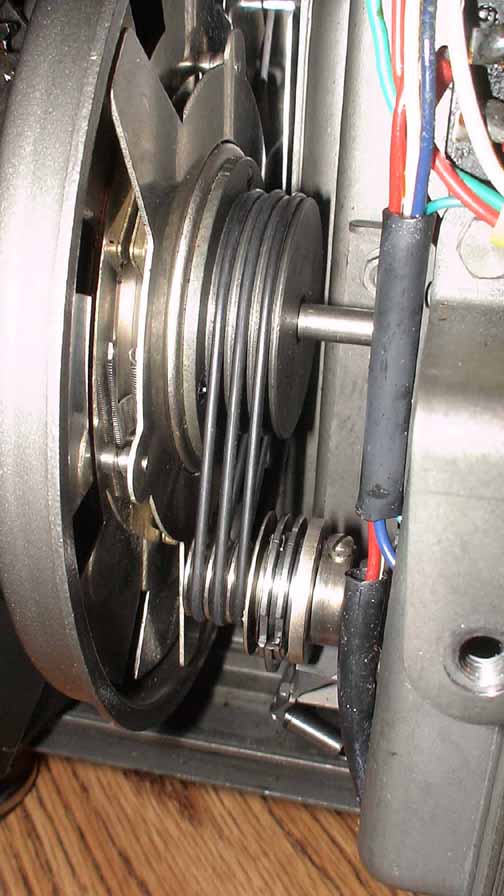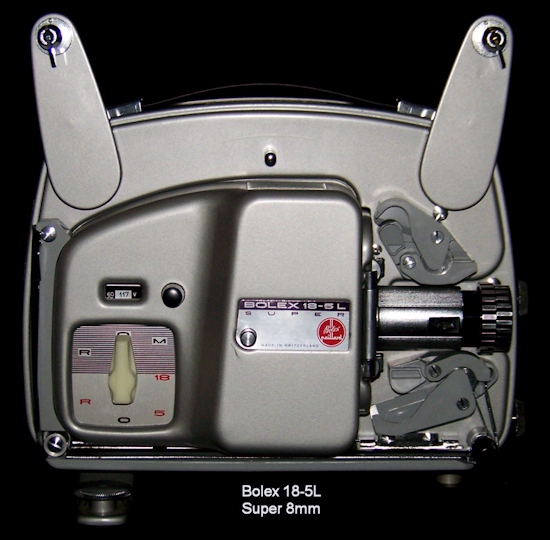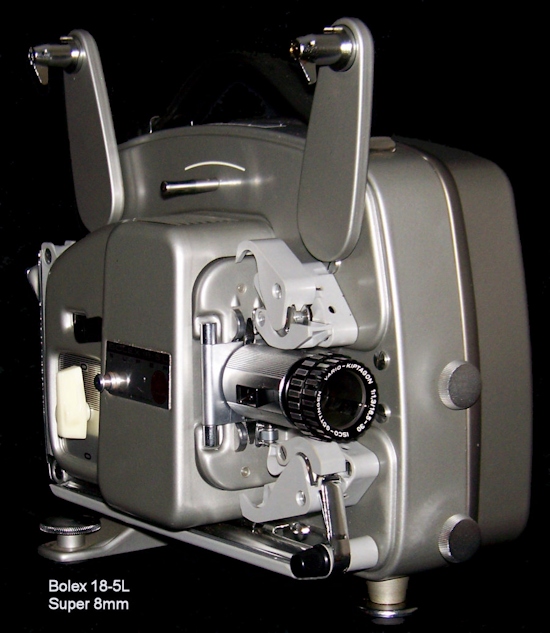|
Author
|
Topic: Test Report - Bolex 18-5
|
Paul Adsett
Film God
Posts: 5003
From: USA
Registered: Jun 2003
|
 posted January 18, 2015 02:01 PM
posted January 18, 2015 02:01 PM



A frequent request on this forum is for recommendations for a good silent regular 8mm or super 8mm projector. I can heartily recommend the Bolex 18-5 projector, which is available in both formats. Here is my test report.

The Bolex 18-5 series, which were manufactured in the early 1960’s, is the successor of the superb 1950’s Bolex M8 series projectors. The Bolex M8 is generally regarded as probably the best silent 8mm projector ever made, the whole projector being a bench mark of Swiss precision engineering and manufacturing quality. The 18-5 is built to the same superb Bolex design and manufacturing quality as the M8. First, it is an all metal machine , except for a couple of plastic rollers and knobs, and the finish of the metal parts is so good that the whole projector has that wonderful ‘wet metal’ look about it. Nothing shines quite like a Bolex 8mm projector. The projector is extremely compact, but the construction gives it a very solid and substantial feel. This is no flimsy plastic toy, it is designed to be a reliable work horse.
Spool capacity is a maximum of 400ft, and it has power rewind and reverse projection capability, as well as a unique 5 frames per second projection feature.
The M8 used a mains voltage 500 watt lamp, so although the light output was pretty good by 1950’s standards, it was like having a 500 watt heater in your room, which was probably fine for European winter evenings but not so good in tropical climates! The 18-5 uses low voltage halogen lighting using the 8v 50 watt CXL or CXR lamp. This lamp comes in two versions, one being the ‘Robby the Robot’ lamp and the other a more conventional lamp with a built in reflector. I can see no performance difference between the two. Both lamp types are readily available. The lamp can be centered by two X an Y adjusting knobs inside the lamp house.
Removing the lamp house cover also gives access to the transformer voltage adjustment knob which can be set at 110v to 230 v. The setting is visible through a slot in the lamphouse cover.
A great feature of the 18-5 is that it has a rear sprung gate, a rare feature on 8mm projectors, and what this means is that the focus remains constant throughout the projection of a reel, even through splices or with films of different thickness. Front sprung gates will often jump out of focus at splices, or drift during a long reel.
The 18-5 comes in manual threading and automatic threading models. The manual threading machine is the one I prefer. The gate swings wide open for threading and the loops can be manually formed and pushed into the sprockets in a matter of seconds. When you switch the control knob to the forward projection position, the machine just runs with a beautiful purr, extremely smooth and quiet. I have never scratched a single frame of film on this projector. Film steadiness is superb, and framing is accomplished by rotating a knob next to the gate which moves the whole lens assembly up and down as required.
The lens on my machine is the Bolex Hi –Fi 12.5mm to 25mm zoom lens, which gives razor sharp images from corner to corner of the screen. Rotating the knob to the 5 position gives you flicker- free 5 fps projection, a feature I have only rarely used. This is accomplished by a very clever shutter design which has extra blades which automatically swing into place at the lower projection speed.
The cover for the projector screws into place with one knob, and when the cover is in place the whole machine looks like a bread toaster!
A common repair problem on old 18-5’s is the need to replace the existing three OEM rubber drive belts located inside the back cover of the machine. Of course these belts are no longer available, but I have found that three 0.070 ins diameter Butyl rubber 0-rings work wonderfully. I replaced mine 30 years ago, and they still look and run like new.

I use my 18-5 exclusively for projecting my old family 8mm Kodachrome’s, a task which it never fails to perform faultlessly, to the amazement of friends and family alike, who never knew that 8mm Kodachrome projected on a fine machine like this, could look better than HD video.
Summary:
Bolex 18-5 projector, beautiful looking compact projector with superb Swiss precision design and solid all metal build quality, excellent performer in all respects, with smooth quiet and rock steady film projection. Will probably last 200 years!
Very highly recommended.
[ January 19, 2015, 12:03 PM: Message edited by: Paul Adsett ]
--------------------
The best of all worlds- 8mm, super 8mm, 9.5mm, and HD Digital Projection,
Elmo GS1200 f1.0 2-blade
Eumig S938 Stereo f1.0 Ektar
Panasonic PT-AE4000U digital pj
| IP: Logged
|
|
|
|
|
|
|
|
|
|
|
|
|
|
|
|
|
|
|
|
|
|
|
|
|
|
|
|
|
|
|
|
|
|
|
|
Paul Adsett
Film God
Posts: 5003
From: USA
Registered: Jun 2003
|
 posted January 21, 2015 11:07 AM
posted January 21, 2015 11:07 AM



Here is a close up pic of the 18-5 drive arrangement:

The motor runs at a constant fixed speed, and a mechanical clutch arrangement on the motor shaft, activated by a linkage from the main control knob, reduces the motor shaft rotation by a factor of 5/18 when the knob is turned to the 5fps position. This is a very clever design and I can't tell how it works without taking it apart, which I am not about to do.
Three belts, mounted on pulley grooves in the motor shaft connect to three corresponding pulley grooves on the shutter/cam shaft. I have no idea why three belts were used as they all rotate together, but whatever it works well. The shutter itself is actually three shutters, each with three blades. They are mounted one behind the other, and two of the blades are weighted and spring loaded so that at 18fps centrifugal force on the weights overcome the spring force and all three shutters swing into alignment, and you have a normal three bladed shutter. At the 5fps speed the spring load on the shutter dominates and the shutters all line up between each other, and you have a 9-bladed shutter, which results in no flicker at the 5fps speed.
The whole thing is devilishly clever, and works like a charm. Another example of brilliant Bolex design.
--------------------
The best of all worlds- 8mm, super 8mm, 9.5mm, and HD Digital Projection,
Elmo GS1200 f1.0 2-blade
Eumig S938 Stereo f1.0 Ektar
Panasonic PT-AE4000U digital pj
| IP: Logged
|
|
|
|
|
|
|
|
|
|
|
|
|
|
|



 UBBFriend: Email this page to someone!
UBBFriend: Email this page to someone!
 Printer-friendly view of this topic
Printer-friendly view of this topic








![[Smile]](smile.gif)






